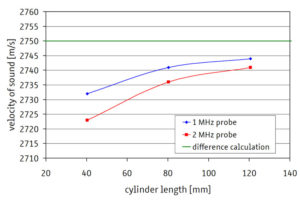Speed of Sound in Solids
Determination of the longitudinal speed of sound in acrylic at two different sound frequencies
The aim of the experiment is to investigate and determine the longitudinal speed of sound in acrylic at two different sound frequencies. To do this, time-of-flight measurements are carried out on three acrylic cylinders of different lengths using the pulse-echo method (ultrasonic A-scan).
Keywords: propagation of ultrasonic waves, acoustic impedance, reflection, sound propagation time, sound velocity, pulse-echo method, ultrasound A-scan
Ultrasonic waves propagate in a medium at a speed that depends on the material and can be frequency-dependent. In gases and liquids, sound propagates only in the form of longitudinal waves. In contrast, transverse waves can also occur in solids due to their elastic properties. Transverse and longitudinal waves generally propagate at different speeds. The speed of sound of the longitudinal waves generated in a solid when sound is coupled in vertically can be easily determined by measuring the time of flight using the pulse-echo method. By using test specimens of different lengths and sound probes of different frequencies, statements can be made in the test about the frequency dependence of sound propagation and about sources of error caused by the design of the ultrasonic probes used.
Speed of sound depending on cylinder length and probe frequency
The sound speeds calculated from the measured travel times have a systematic error, the influence of which decreases with increasing measuring distance and is caused by the measured travel time in the adaptation layer of the probes. In this case, the 2 MHz probe has a thicker adaptation layer, so that the sound speeds determined with it have a larger error. This error can be eliminated by calculating the difference between two measurements with different sample lengths (green line in the graph, cL = 2750 m/s, same values for both frequencies, no dispersion).
SCOPE OF DELIVERY:
| Item No. | Designation |
|---|---|
| 10400 | Ultrasonic echoscope GS200 |
| 10151 | Ultrasonic probe 1 MHz |
| 10152 | Ultrasonic probe 2 MHz |
| 10207 | Test cylinder set |
| 70200 | Ultrasound gel |
ADDITIONAL EXPERIMENTS:
| PHY07 | Transverse waves in solids |
| IND01 | Non-destructive testing (NDT) |
| IND06 | Angle head testing |
| MED04 | Biometrics on the eye model |




